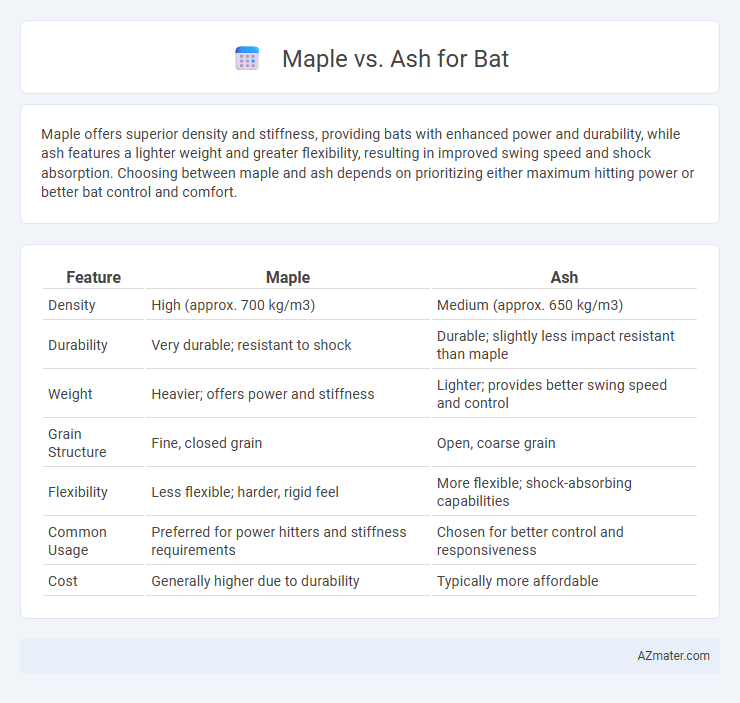Maple offers superior density and stiffness, providing bats with enhanced power and durability, while ash features a lighter weight and greater flexibility, resulting in improved swing speed and shock absorption. Choosing between maple and ash depends on prioritizing either maximum hitting power or better bat control and comfort.
Table of Comparison
| Feature | Maple | Ash |
|---|---|---|
| Density | High (approx. 700 kg/m3) | Medium (approx. 650 kg/m3) |
| Durability | Very durable; resistant to shock | Durable; slightly less impact resistant than maple |
| Weight | Heavier; offers power and stiffness | Lighter; provides better swing speed and control |
| Grain Structure | Fine, closed grain | Open, coarse grain |
| Flexibility | Less flexible; harder, rigid feel | More flexible; shock-absorbing capabilities |
| Common Usage | Preferred for power hitters and stiffness requirements | Chosen for better control and responsiveness |
| Cost | Generally higher due to durability | Typically more affordable |
Introduction to Maple and Ash Bats
Maple bats are renowned for their dense grain structure, providing exceptional durability and a solid, powerful feel preferred by power hitters in baseball. Ash bats feature a lighter, more flexible wood with a pronounced grain pattern, offering enhanced bat speed and a traditional feel favored by players valuing control and quickness. Both woods are popular in professional baseball, with maple's hardness contributing to longevity and ash's flexibility promoting a balanced swing.
Historical Use in Baseball
Maple bats have dominated Major League Baseball since the 1990s due to their hardness and durability, offering increased hitting power that suited modern players' preferences. Before this shift, ash bats were preferred for over a century, prized for their lightweight nature and flexibility, which provided superior swing control and reduced vibration on impact. Historical records show that legends like Babe Ruth and Ted Williams famously used ash bats, while stars such as Barry Bonds popularized the transition to maple, influencing the bat manufacturing industry significantly.
Physical Properties Comparison
Maple bats offer greater hardness and density, providing enhanced durability and a solid hitting surface ideal for powerful swings. Ash bats are lighter with more flexibility, allowing for quicker bat speed and better swing control, favored by players seeking balance between strength and agility. The denser grain structure of maple contributes to less vibration and a stiffer feel compared to the more porous and shock-absorbing nature of ash wood.
Durability and Longevity
Maple bats offer exceptional durability due to their dense, hard grain structure, making them resistant to dents and cracks, which extends their lifespan significantly compared to other woods. Ash bats provide superior flexibility and a lighter swing weight, but they are more prone to chipping and cracking over time, potentially reducing their longevity under high-impact use. The choice between maple and ash ultimately depends on a player's preference for durability versus a balanced feel and swing speed.
Performance and Feel at the Plate
Maple bats deliver exceptional power and durability due to their dense grain structure, making them a top choice for players seeking maximum performance at the plate. Ash bats offer a lighter feel and more flex, providing quicker swing speed and enhanced control for hitters prioritizing bat speed and contact. While maple bats excel in hardness and pop, ash bats' natural whip effect benefits players focused on balance and precision in their swings.
Weight and Swing Speed Differences
Maple bats are generally heavier than ash bats, which can affect swing speed by making it slightly slower but offering more power upon contact. Ash bats have a lighter density, allowing for faster swings and greater control, making them ideal for players prioritizing swing speed. Choosing between maple and ash bats depends on whether a player values power from weight or enhanced swing speed for quicker reactions.
User Preference and Playing Style
Maple bats provide a harder, denser wood that offers a more powerful pop, preferred by players with aggressive hitting styles seeking maximum ball exit velocity. Ash bats feature a lighter, more flexible wood that enhances bat speed and control, ideal for players who prioritize contact hitting and quick swing adjustments. User preference often depends on balancing power versus bat speed, with maple favored for strength-focused hitters and ash chosen by those valuing bat flexibility and swing fluidity.
Professional Player Choices
Professional baseball players often prefer ash bats for their lighter weight and superior flex, which enhance swing speed and control. Maple bats are favored for their denser wood, providing increased power and durability, making them ideal for hitters seeking harder contact and longer bat life. The choice between maple and ash ultimately depends on a player's hitting style, with power hitters leaning toward maple and those prioritizing bat speed opting for ash.
Price and Availability
Maple bats generally command a higher price due to their superior hardness and durability, making them a preferred choice among professional players. Ash bats are more widely available and typically cheaper, offering a lightweight option that appeals to amateurs and budget-conscious buyers. Availability of maple bats can be limited in certain regions, whereas ash bats have broader distribution in sporting goods stores nationwide.
Which Bat is Right for You?
Maple bats offer a denser wood structure, providing increased power and a harder hit ideal for players seeking maximum velocity and durability. Ash bats feature a lighter, more flexible grain, resulting in better swing control and quicker bat speed, suited for players who prioritize precision and maneuverability. Choosing the right bat depends on your hitting style: power hitters often prefer maple for its stiffness, while contact hitters may favor ash for its responsiveness.

Infographic: Maple vs Ash for Bat
 azmater.com
azmater.com